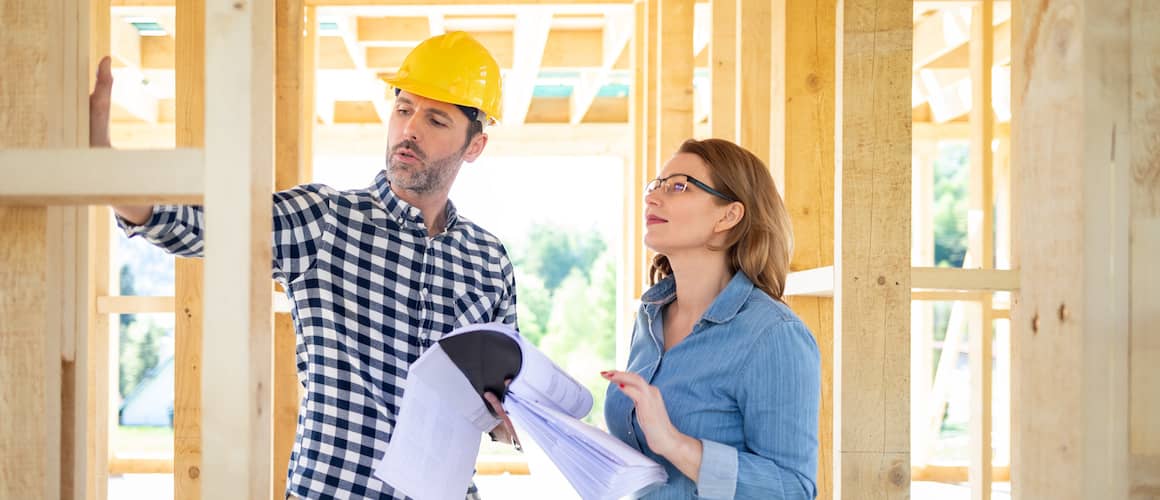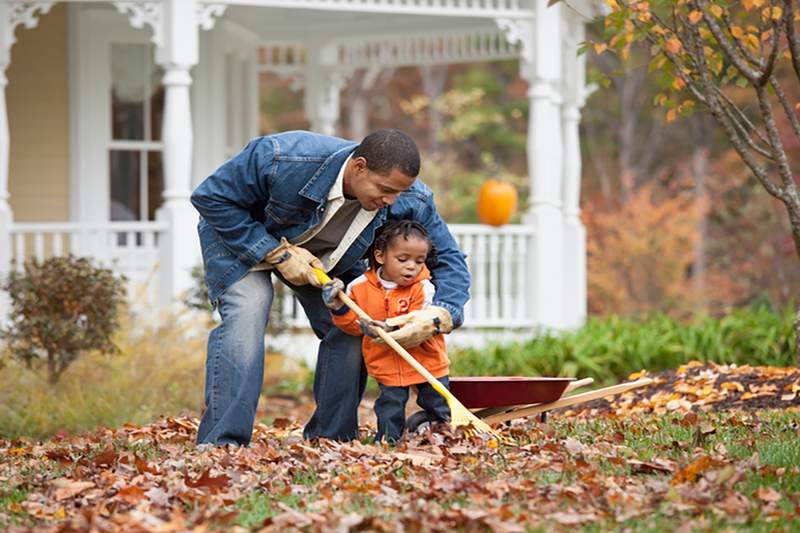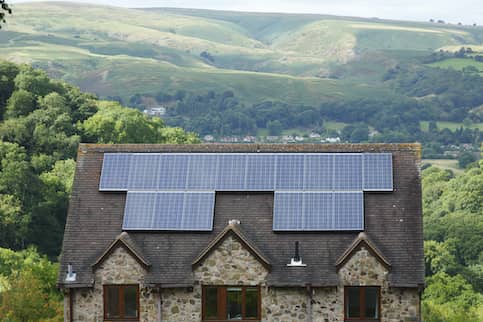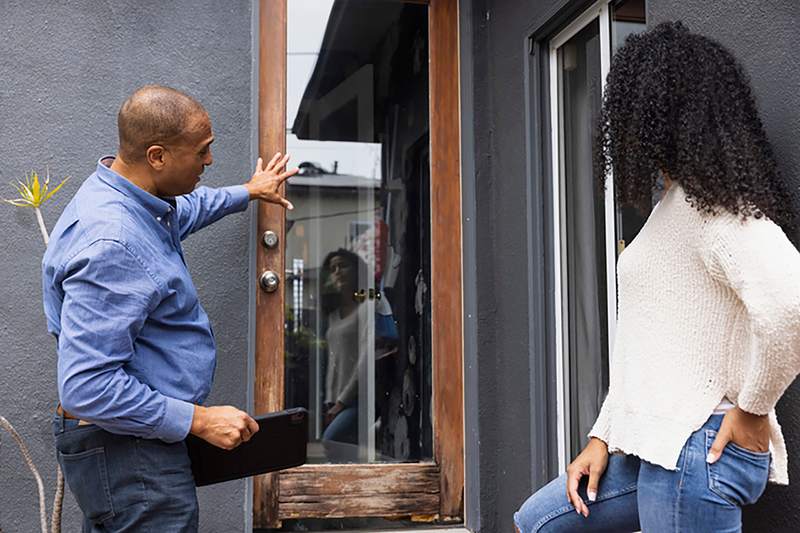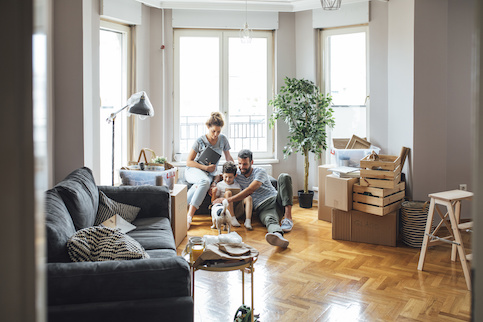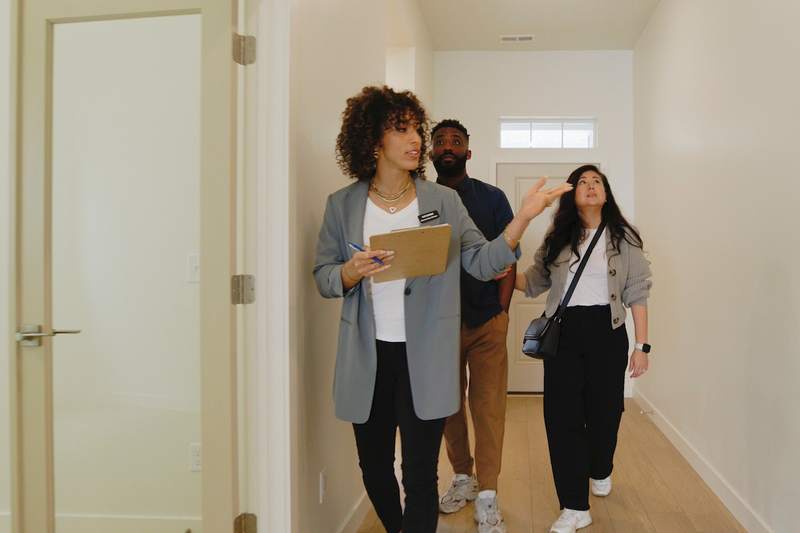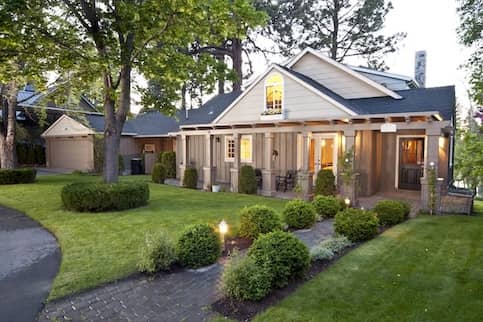Some people want to build their dream home from the ground up, and it’s easy to see why. You’re in control of the property and its features. Whether you want cutting-edge energy-efficiency or hot design trends – it’s all in your hands. Plus, you may avoid the cutthroat competition of buying a house in a hot real estate market.
Let’s review the typical costs associated with building a home, including buying land, obtaining permits, designing the property and building it and the necessary materials.
Cost To Build A House: An Overview
Over the previous years, supply chain shortages caused by the COVID-19 pandemic have affected the cost to build a home, making materials and labor more costly. However, the Federal Reserve’s efforts to offset inflation could help stabilize home-building costs in the coming years.
The pricing for the following sections comes from data collected during 2022 and part of 2023. However, they should help you plan for any upcoming construction. Still, always discuss pricing with professionals before you start budgeting.
Average Cost To Build A House
The average cost to build a new house in the U.S. is $308,588, as of January 2023, according to HomeAdvisor. Of course, your cost to build a home will depend on your square footage, number of bedrooms, geographical location of the home and more.
Category | Average Cost |
|---|---|
National Average To Build A Home | $308,588 |
Minimum Average Costs | $1,500 |
Maximum Average Costs | $900,000 |
Average Range | $117,685 – $499,842 |
Average Cost Per Square Foot
New home constructions typically cost $150 per square foot to build. However, the average cost to build a new home ranges from $50 – $400 per square foot depending on the type of home you’re building and the amenities you’re planning to include.
Building a bigger home also results in higher costs due to additional building materials and labor costs. But there’s no hard and fast rule. Price calculations vary depending on which spaces get included in the measurement (like the attic, exterior, basement, etc.), features, the land, neighborhood, building materials, design and more.
Average Cost Per Number of Bedrooms
The number of bedrooms you plan to include will also affect the total cost.
Number Of Bedrooms | Average Cost |
|---|---|
3-Bedroom House | $146,400 |
4-Bedroom House | $285,000 |
5-Bedroom House | $375,000 |
Average Cost Based On Location
Location is one of the major drivers of cost when building a house. It impacts everything from construction costs to labor costs. That’s because the price depends on the relationship between supply and demand. Some states have a higher demand than others, making it more costly to build there.
Here are some examples of the average expense ranges per state:
State | Average Cost |
|---|---|
Alabama | $290,000 |
Arizona | $412,500 |
California | $400,300 |
Colorado | $260,100 |
Connecticut | $550,000 |
Florida | $295,000 |
Georgia | $250,000 |
Illinois | $265,440 |
Maryland | $290,000 |
Massachusetts | $425,000 |
Michigan | $245,000 |
Mississippi | $240,000 |
Missouri | $226,760 |
New York | $600,000 |
North Carolina | $385,000 |
Ohio | $222,480 |
Oregon | $287,500 |
Pennsylvania | $397,500 |
South Carolina | $350,000 |
Tennessee | $282,500 |
Texas | $264,100 |
Virginia | $380,000 |
Washington | $325,000 |
Wisconsin | $310,000 |
See What You Qualify For
Buy A Home
Discover mortgage options that fit your unique financial needs.

Refinance
Refinance your mortgage to have more money for what matters.
Tap Into Equity
Use your home’s equity and unlock cash to achieve your goals.
Breaking Down The Costs Of Building A Home: Step-By-Step
Before tackling any project, you should examine what it entails. That includes both the work involved and the prices. With that in mind, here are some of the most crucial steps when building a house and their average costs.
1. Plot Of Land
If you want to start your home on the right foot, you need to choose the land you build on carefully. You can’t decide based on looks or good views alone.
A plot of land may seem nice but could contain contaminants in the soil, come with high zoning costs or be prone to natural disasters. As a result, it’s vital to do your due diligence and check all factors. Failing to do so can add thousands to your building expenses.
Average Land Costs
In general, a plot of land may cost $3,000 – $150,000.
Lots tend to be finished in urban areas, meaning they hook into water lines, sewers and the electric grid. Comparatively, you’re more likely to find unfinished lots in rural areas, resulting in lower costs. The average per-acre cost of raw land in a rural area is only $3,800, according to the U.S. Department of Agriculture (USDA) Land Values 2022 summary.
Additionally, you will need to clear and prepare the land before building. The national average cost is around $1,300 – $5,800, but heavily forested areas can cost more.
2. Building Permits
Once you purchase your plot of land, your contractors and subcontractors can start preparing. They’ll need to contact your local municipal office to receive the necessary permits. Sometimes a contractor already has a relationship with your municipality which speeds up the process.
Building permits are official documents that authorize you to begin constructing the property. The requirements, building codes and associated fees vary depending on where you want to build, so it’s wise to check them beforehand. During the construction process, a representative from the local Department of Building and Zoning will inspect the project to ensure it’s up to code.
Average Building Permit Costs
Some of the permits you may need, and their average price range, include:
- Building permit: $1,200 – $2,000
- Basement permit: $50 – $2,000
- Electrical permit: $10 – $500
- HVAC permit: $250 – $400
- Plumbing permit: $50 – $500
3. Contractor(s) And Labor
A crucial figure in your project is the general contractor. This individual oversees the entire construction process of your home from beginning to end. They take on important responsibilities, including obtaining cost estimates, vetting and hiring a team of subcontractors and ensuring deadlines are met.
A general contractor is technically different from a custom home builder. The latter specializes in custom homes and draws up blueprints – two features the general contractor doesn’t share.
Average Labor Costs
A general contractor charges around 10% – 20% of the construction’s total cost, sometimes called “cost plus.” Some contractors may agree to hourly rates as well.
After you have a contractor, you need subcontractors. Each one specializes in a certain type of installation or task, such as security system installation or carpeting. They charge a similar hourly rate to general contractors. For example, you could expect to pay the following professionals these average rates:
- Draftspeople: $50 – $130 per hour
- Interior designers: $50 – $200 per hour
- Landscaping architects: $70 – $150 per hour
- House framers: $7 – $16 per square foot
- Electricians: $50 – $100 per hour
- Plumbers: $45 – $200 per hour
4. Foundation
Breaking ground is the next step once you finish all the prep work. At this time, a crew comes in to dig out the space needed for the foundation of your home.
The foundation isn’t the same for every home. The company will pour concrete depending on the type of foundation you choose, including a slab, crawl space or basement. A slab is generally the cheapest and a full basement is usually the most expensive. A crawl space tends to sit in the middle, cost-wise. The size will also influence how much you end up spending.
Average Foundation Costs
Your preferences and budget will determine which one you choose. However, each one has its advantages and disadvantages. The cost for a foundation averages $5 – $37 per square foot. The typical project costs around $9,139, or between $4,028 – $14,454.
Here’s a cost breakdown by type based on averages:
- Monolithic slab: $7,000 – $20,000
- Stem wall: $8,000 – $24,000
- Pier and beam with crawl space: $9,000 – $17,500
- Cement or cinder block: $11,500 – $19,000
- Basement foundation: $24,000 – $44,500
5. Framing
The frame acts as the bones of your home. It supports all the finished features, including your windows, roof, doors, walls, and even garage (if you want one). The overall cost to frame a house includes both labor and materials.
So, you will need to factor in how long it will take to complete this stage of construction, along with the amount of material needed. As a result, a bigger or more complex home will likely cost more.
Average Framing Costs
Usually, you can depend on the framing to cost $20,000 – $50,000.
6. Exterior Finishes
Once you finish the basic components of the interior fixtures and drywall, you start on the exterior. That involves installing features such as doors, roofing, walls and windows. This may also be the step where the builders work on walkways, driveways and patios. However, some crews prefer to wait until the very end of construction to pour the driveway.
Average Exterior Finishing Costs
Exterior work helps complete the look of your property and generally costs $40,000 – $60,000. Multiple openings and your chosen finish affect this price, though.
7. HVAC And Other Major Systems
Electrical, HVAC and plumbing account for most of your system costs. That’s because installing these systems is usually labor-intensive. But you can’t skimp in this area since these major systems are critical to the health and safety of the home’s occupants. They also impact the efficiency of your property, meaning cutting corners will cost you in the long run.
Average Home System Costs
System installation costs around $30,000 – $75,000 overall, but the type and size of the systems may change that. You could expect to see a cost breakdown similar to this:
- Plumbing: $7,500 – $15,000
- Electrical wiring: $20,000 – $30,000
- HVAC system: $1,500 – $13,000
8. Interior Finishes
While you might be tempted to cut costs when it comes to finishing the interior of your home, you don’t want to make decisions in this area based on utility. Instead, you want your dream home to accurately reflect your style and unique tastes. As a result, any special touches or customizations will result in higher costs. However, you may be able to reduce some costs if you DIY any features.
Average Interior Finishing Costs
You can estimate interior finishes will cost $50,000 – $100,000, but that’s only based on averages. Interior home finishing can run much higher than that because it’s based on personal preference. For example, if you choose luxury upgrades, such as marble countertops, hardwood floors or smart appliances, your total house cost could be higher than average.
Home Buyer’s Guide
Follow our step-by-step guide to learn how to buy a home.
Average Home Building Material Costs
As mentioned previously, the cost of building materials fluctuated throughout the COVID-19 crisis and because of supply chain issues and inflation in 2022. As a result, the current costs of materials appear much higher than in recent years. That, in turn, can impact your bottom line while building a new home.
Considering that, here are some of the latest building material averages to know.
Lumber
Lumber is the backbone of many projects when it comes to building a home. Builders use a variety of types, from cedar to spruce to pine. But most usually refer to the different forms as engineered wood, hardwood and softwood.
Hardwood offers greater strength and durability, making it good for furniture, flooring, walls and ceilings. In comparison, windows, framing and interior moldings typically call for softwood. Engineered wood is versatile, serving as the material for flooring, siding and subflooring in many newer homes.
Average Lumber Costs
Building materials experienced price hikes during and after the COVID-19 pandemic. Lumber, in particular, increased – adding $14,345 to the cost of your average new single-family house, according to 2022 data from the National Association of Home Builders (NAHB).
As of April 2023, lumber prices have started to come down and are estimated at $351.80 per thousand board feet, according to Statista.
Concrete
Concrete is a common building material that offers a variety of advantages. To start, it is less vulnerable than wood to certain external threats, such as mold, moisture and fire. In addition, concrete is durable and helps increase energy efficiency in a building due to its ability to retain heat. So, you can save on your cooling and heating bills.
Average Concrete Costs
Expect to pay approximately $1,000 – $10,000 for the material on its own. This will vary based on the thickness of the concrete, the thickness of the edge and finish.
If you want to use concrete to build the home itself, you’re looking at a $204,000 – $416,000 project. The type of wall you choose (retaining, block or stamped) will also impact the total expense.
Roofing
Having a well-built roof is vital to the structural integrity of your new house. That’s why it’s important to choose a roofing material that works for your climate. The most common materials used are asphalt shingles, metal sheets or cedar shingles.
Average Roofing Material Costs
Many homeowners in the U.S. install asphalt shingles on their properties. They’re an affordable option that is versatile and easy to find, costing around $100 – $150 per square.
Metal roofing comes in sheets or shingles, is low-maintenance and can last decades longer. In comparison, it costs $120 – $900 per square, depending on its material and design.
Alternatively, there is wood roofing. You often see this on Cape Cod cottages or Tudor-style homes. Although, they last the longest in areas with dry climates. The popular cedar shake-style roofing averages $250 – $600 per square.
Overall, the average price for roofing generally ranges from $5,000 – $10,000. Keep in mind that a quote for most projects covers both product and labor costs.
Siding
Siding is crucial to protect your home from the elements, like snow, rain and wind. It also plays a role in insulating your home and prevents damage to the foundation from risks such as water and pests. It can even help with your home’s energy efficiency.
On the other hand, poorly installed or cheap siding makes your house vulnerable to harm. So, it’s important to choose a durable product.
Average Siding Costs
Siding typically costs around $2 – $5 per square foot. However, this depends on the type of material. Here are some of the most popular siding options and their average cost per square foot (based on a single-family home):
- Aluminum: $5 – $11
- Engineered wood: $4 – $6.50
- Fiber cement: $5 – $25
- Stone veneer: $6 -– $15
- Stucco: $7 – $9
- Vinyl: $3 – $12
- Wood: $3 – $10
Drywall
Drywall, sometimes called wallboard or plasterboard, is made up of gypsum sandwiched by two paperboards. There are different types of drywall, each with its own benefits. The four basic categories outside of the standard drywall include: fire-resistant, mold-resistant, moisture-resistant and soundproof.
You use this material to create the walls and ceilings of your home. And it’s used instead of plaster in new home constructions, partly due to its ease of installation.
Average Drywall Costs
Drywall costs around $10 per 4-foot-by-8-foot panel. Thicker panels made for soundproofing can cost as much as $50 while mold-resistant drywall costs about $13 – $15 per sheet, fire-resistant drywall costs $13 per sheet and moisture-resistant sheets cost $14 – $25.
Flooring
Flooring not only impacts the appeal of your home but also its market value. It’s the starting point for design in each room of your home, affecting the functionality and enjoyment of the space.
Average Flooring Costs
Both the labor and materials heavily factor into the cost of flooring. You can plan to pay around $1 – $5 in general per square foot. However, you may pay more or less depending on the material. A price breakdown looks something like this:
- Carpet: $760 – $2,540
- Hardwood: $2,500 – $6,740
- Laminate: $1,400 – $4,240
- Linoleum or vinyl: $790 – $2,630
- Tile: $890 – $2,760
FAQs About The Cost Of Building A House
Learn more about the cost of building a home with the answers to these commonly asked questions.
How can I finance the cost of building a home?
If you don’t have enough savings to pay cash, you’ll most likely need to use a construction loan to fund your dream home. This type of financing covers the cost of labor and materials throughout the construction process. But once the home is built, you can refinance the loan and replace it with a mortgage.
Is it more affordable to buy or build a home?
Determining if buying or building a home is more cost-effective depends on where you live and what type of house you’d construct. On average, the cost to build a home is $308,588 but the median sales price of a home in the U.S. is about $431,000, as of the third quarter of 2023, according to the Federal Reserve Bank of St. Louis. Of course, your cost to build could be higher, for example, if you opt for higher-end finishes or more bedrooms.
What are the pros and cons of building a home?
Building a home allows you to customize your needs and wants. Do you want a four-car garage but only two bedrooms? You can adjust your floor plan to make it happen. While this can be the most important benefit for homeowners, there are drawbacks. Building a home can take longer than buying one and costs for labor and materials can fluctuate greatly, making it hard to stick to a budget.
The Bottom Line
When building your own home, managing your expectations is key. You’ll need to consider all the costs – as well as all the time – that you’ll be required to commit to a project of this magnitude. It also helps to consider all your options, including whether it makes more sense to purchase or build your dream home.

Ashley Kilroy
Ashley Kilroy is an experienced financial writer who writes for solo entrepreneurs as well as for Fortune 500 companies. She is a finance graduate of the University of Cincinnati. When Ashley isn’t helping people understand their finances, you may find her cage-diving with great whites or on safari in South Africa.
